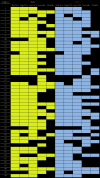Decline in semicircular canal and otolith function with age
- PMID: 22699991
- PMCID: PMC3376350
- DOI: 10.1097/MAO.0b013e3182545061
Decline in semicircular canal and otolith function with age
Abstract
Objective: To characterize the physiologic nature of the vestibular dysfunction that occurs with the normative aging process.
Study design: Cross-sectional study.
Setting: Tertiary care academic medical center.
Patients: Fifty individuals age 70 years and above.
Interventions: Head thrust dynamic visual acuity testing and cervical and ocular vestibular-evoked myogenic potential (VEMP) testing.
Main outcome measures: Semicircular canal function measured by head thrust dynamic visual acuity testing in each of the 3 semicircular canal planes, and saccular and utricular function measured by cervical VEMP and ocular VEMP testing, respectively.
Results: We observed significant declines in semicircular canal function in each of the canal planes as well as otolith function associated with aging. We found that individuals with impaired horizontal and superior semicircular canal function also were likely to have concomitant deficits in utricular but not saccular function. Overall, we noted that the prevalence of semicircular canal dysfunction was highest followed by saccular then utricular impairment, although we did observe individuals with isolated otolith deficits.
Conclusion: These data suggest an overall decline in semicircular canal as well as otolith function associated with aging, although the magnitude of impairment was greater for the semicircular canals than the otoliths in this elderly population. A better understanding of the specific vestibular deficits that occur with aging can inform the development of rational screening, vestibular rehabilitation, and fall risk reduction strategies in older individuals.
Figures










References
-
- Tinetti ME. Clinical practice. Preventing falls in elderly persons. N Engl J Med. 2003 Jan 2;348(1):42–49. - PubMed
-
- Tinetti ME, Speechley M, Ginter SF. Risk factors for falls among elderly persons living in the community. N Engl J Med. 1988 Dec 29;319(26):1701–1707. - PubMed
-
- Herdman SJ, Blatt P, Schubert MC, Tusa RJ. Falls in patients with vestibular deficits. Am J Otol. 2000 Nov;21(6):847–851. - PubMed
-
- Agrawal Y, Carey JP, Della Santina CC, Schubert MC, Minor LB. Disorders of balance and vestibular function in US adults: data from the National Health and Nutrition Examination Survey, 2001-2004. Arch Intern Med. 2009 May 25;169(10):938–944. - PubMed
Publication types
MeSH terms
Grants and funding
LinkOut - more resources
Full Text Sources
Medical

